Where Does it Go?! It’s Magic!
By Kalpna Solanki CPHI(C) BSc MBA
Many of us travel on the various BC Ferries routes, we go to the washroom, flush toilets, and wash our hands. But where does the water come from, and where does the wastewater go to? It’s like magic…well maybe not, but almost!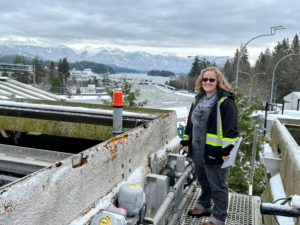
In the case of the ferries that travel to and from the Langdale terminal on the Sunshine Coast, the vessels pump off wastewater, which then goes via force main to a lift station and ultimately to a wastewater treatment facility right at the Langdale ferry terminal. Similarly, the terminal washrooms empty into lift stations which pump up to the treatment facility located at the top of the terminal beside the tollbooths.
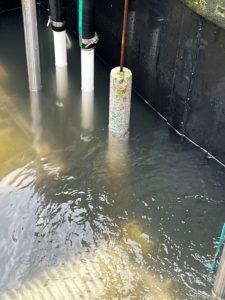 Something that makes this treatment facility unique is that the vessels on this route have the ability to use saltwater for flushing toilets on board while the terminal washrooms use freshwater. The combination of freshwater and saltwater, high nitrogen concentration, plus the seasonal changes in flows, make for an especially challenging treatment process. A cathodic protection system reduces the damaging impact of the salinity on the process tanks and a sprinkler system controls foaming that can occur when the influent water chemistry variations result in upsetting the biology of the plant.
Something that makes this treatment facility unique is that the vessels on this route have the ability to use saltwater for flushing toilets on board while the terminal washrooms use freshwater. The combination of freshwater and saltwater, high nitrogen concentration, plus the seasonal changes in flows, make for an especially challenging treatment process. A cathodic protection system reduces the damaging impact of the salinity on the process tanks and a sprinkler system controls foaming that can occur when the influent water chemistry variations result in upsetting the biology of the plant.
A grinder pump in the lift station pumps the wastewater through the inclined screw screen at the facility headworks. The wastewater then goes to two equalization tanks, each with a volume of 100 m3 with a third emergency overflow tank in case of influent screen failure. The oversized equalization tanks hold nearly the same volume as the process tanks because the vessels generate approximately 90% of the total wastewater which is pumped up to the plant during one or two pump ashore procedures per day.
From the equalization tanks, the wastewater is dosed into the treatment process starting with an anoxic tank where denitrification occurs and then free flowing to the aeration tank. The addition of caustic soda maintains pH and adds alkalinity for the biological nitrification process that occurs in the aeration tank. Maintaining an MLSS concentration of 10,000 ppm makes the plant very resilient to process upsets when the influent salinity or flow varies.
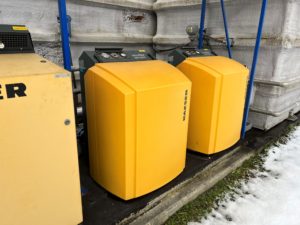 The next step in the process is two membrane bioreactor tanks each containing two Toray microfiltration membrane cassettes. Each cassette processes up to 63 m3/day and can be run one at a time or all four simultaneously depending on influent flow conditions. The pore size of these membranes are 0.08 microns and this acts as a physical barrier to separate the effluent from the return activated sludge. Unlike a traditional treatment process that relies on flocculation and sedimentation, the physical barrier of a membrane decouples the hydraulic and sludge retention times, which protects the process from washout and keeps the effluent free from particles larger than the pore size.
The next step in the process is two membrane bioreactor tanks each containing two Toray microfiltration membrane cassettes. Each cassette processes up to 63 m3/day and can be run one at a time or all four simultaneously depending on influent flow conditions. The pore size of these membranes are 0.08 microns and this acts as a physical barrier to separate the effluent from the return activated sludge. Unlike a traditional treatment process that relies on flocculation and sedimentation, the physical barrier of a membrane decouples the hydraulic and sludge retention times, which protects the process from washout and keeps the effluent free from particles larger than the pore size.
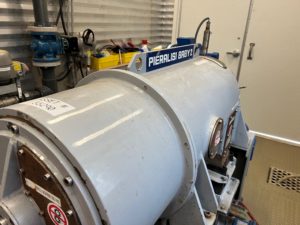 The final step is to disinfect the membrane filtrate with ultraviolet light. The high-quality effluent from this facility may not contain more than 10 ppm TSS or BOD, 1.03 ppm total ammonia nitrogen and 200 CFU of fecal coliforms. The facility is diligently maintained by Mardell Buryniuk MSc CWP CWWP who holds certifications in WT, WWT, SWS, and SWWS, and she very capably ensures that the discharge limits are never exceeded.
The final step is to disinfect the membrane filtrate with ultraviolet light. The high-quality effluent from this facility may not contain more than 10 ppm TSS or BOD, 1.03 ppm total ammonia nitrogen and 200 CFU of fecal coliforms. The facility is diligently maintained by Mardell Buryniuk MSc CWP CWWP who holds certifications in WT, WWT, SWS, and SWWS, and she very capably ensures that the discharge limits are never exceeded.
The waste activated sludge dewatered through a Pieralisi centrifuge with the addition of a long chain polymer to produce a cake of about 18% solids. The cake is then delivered to Salish Soils for composting.
There is a small lab at the facility for operational measurements of pH, dissolved oxygen, SVI and TSS, but other operational and regulatory samples are sent to external labs for analysis.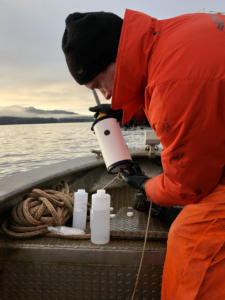
This wastewater treatment facility is unique in that it essentially serves a population of zero, or thousands, depending on the interpretation of the regulations. At this time, the facility is considered a small wastewater system and will be re-evaluated against current classification models.
